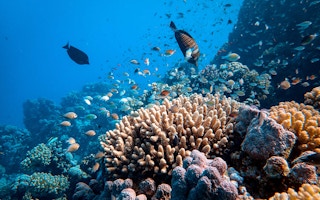Southeast Asia has an integral part to play in addressing the climate emergency. The region is at a pivotal stage of transformation: we are seeing rapid economic growth, urbanisation and increasing energy demand, and yet the region remains home to some of the world’s most vulnerable coastal communities which are dependent on precious marine ecosystems. A balance between economic advancement, the conservation of ecosystems and climate change adaptation must be struck, with hundreds of millions of lives at risk along our coasts. The clock is ticking, but we still have a window of opportunity to act.
Understanding ocean-climate 101
Whilst the term “ocean-climate” has been in use for several years, it is unfamiliar to many in our region. The term refers to the complex and interconnected relationship between the ocean and the Earth’s climate system. From sequestering carbon to absorbing excess heat and influencing weather patterns, the ocean is a powerhouse in stabilising our climate. As such, policymakers, scientists and conservationists are considering the role the ocean can play in mitigating the effects of climate change.
The ocean absorbs almost a third of carbon dioxide emissions from human activities. Mangroves and seagrasses play a large role in this – they cover less than one percent of the Earth’s surface area, but mangroves can sequester four times more carbon than rainforests, while seagrass captures carbon 35 times faster than rainforests do. Even often-overlooked marine sediments store almost twice as much carbon as terrestrial soil.
Animals like whales also play a role in capturing carbon, and when they die their bodies sink to the ocean floor, locking this carbon away for centuries. But the ocean is a victim of its own efficiency, and excessive carbon absorption is altering water chemistry and increasing acidity, which makes it challenging for coral reefs to build their skeletons and may even be corroding sharks’ teeth and skin. Warmer oceans are attributed to mass die-offs of starfish, premature hatching of sharks from egg cases, and fueling more intense and damaging storms.
Climate change in Southeast Asia
The effects of climate change will be particularly stark in Southeast Asia. The region is archipelagic, with the majority of people living along coastal areas, which makes them vulnerable to sea-level rise – so much so that Indonesia will relocate its capital to evade submersion. Many communities in Southeast Asia are low-income and have a high dependency on the ocean for food, fisheries (almost 25 per cent of the world’s aquaculture and wild capture fisheries production comes from Southeast Asia) and marine tourism. Yet changing ocean conditions are depleting biodiversity: warming waters are driving fishes poleward, away from the tropics and into cooler temperate waters.
Southeast Asia is in trouble, but the region should and can be a greater focal point for solutions. Approximately 50 per cent of the world’s remaining mangrove forest area, and a third of the world’s coral reefs, are found in Southeast Asia. The region also has the highest seagrass diversity in the world. But high rates of habitat destruction, pollution, and exploitation threaten these ecosystems. Bolstering protection and restoration efforts in Southeast Asia are not only vital locally (mangroves, coral reefs and seagrasses help lessen erosion from sea-level rise, and support commercially valuable fishes), but can be key in the global fight against climate change through carbon sequestration. However, there is limited available funding and commitment.
An ocean of opportunity
The opportunities for protecting ocean ecosystems are plenty, but we currently lack speed and scale. Despite covering over 70 per cent of our planet, the ocean remains overlooked. For example, the United Nations Sustainable Development Goal SDG14 “Life below Water”, remains the least funded of all Sustainable Development Goals.
Regional governments, corporates, financial institutions, investors and philanthropies have the ability to contribute by investing in and empowering local communities, scientists, non-profit organisations and innovators to safeguard the ocean’s ecosystems and mitigate climate change impacts. Where vulnerable communities are concerned, conservation must offer social and economic benefits, or else it will be perceived as an inconvenience.
From philanthropic capital to concessionary finance and venture capital, there are promising projects to invest in that span focus areas such as awareness and education, protection and restoration of blue carbon sinks and sustainable seafood. For example, 40 per cent of current global seaweed production occurs in Southeast Asia, a nature-based solution which sequesters carbon, provides livelihoods, and has a large end market (although potential environmental impacts need to be monitored).
Other examples include community-based conservation efforts, technical assistance facilities, blended finance structures and start-ups that are providing exciting interventions that promote the sustainable use of ocean resources. One example is the Blue Economy Technical Assistance Facility (TAF) by Conservation International Asia Pacific that brings together the “twin pillars” of ocean conservation: “protection”, including measures like the creation of marine protected areas; and “production”, which refers to the sustainable development of the blue economy, spanning sectors such as tourism and fisheries.
The TAF looks to protect nature and livelihoods, optimise production, and link protection and production. This will eventually establish blended finance facilities to pool and disburse funding from fisheries and tourism proceeds toward marine resource management.
This crisis calls for urgent, collaborative efforts to safeguard communities and nature, and investors of all sizes have the potential to meaningfully contribute to reshaping our shared future. Solving the climate crisis may be global, but Southeast Asia has the potential to have an outsized impact. Our window of opportunity is now.
Helpful resources
Discover ocean opportunities in our Blue Recovery feature series produced by Eco-Business, and why protecting the ocean would solve climate, food and biodiversity crises.
Access the Ocean Pavilion’s livestream and recordings at COP28 here.
Learn about the Friends of Ocean Action coalition convened by the World Economic Forum here.
Explore the Ocean Impact Navigator, an open-source framework developed by 1000 Ocean Startups to help investors measure ocean impact.
Naomi Clark-Shen is the Ocean-Climate Programme Lead at Rumah Foundation. Kathlyn Tan is the director of Rumah Group and Rumah Foundation.



















